Construction of the KIS Drip Filter System, with 32 Gallon Trash Cans – Filters 204 gallons/day
Click here to buy the KIS Drip Filter System.
Kit Includes
5 KIS Filters
5 KIS Pre-Filter Socks
4 Spigots
Tools
1 5/8” drill bit
1 3/4” drill bit
1 drill
1 pliers
1 crescent wrench (nice but not necessary)
2 wood blocks (for doing leak checking)
You will need to purchase 2 thirty-two gallon, or larger, trash cans. The bottom trash can will need to be strong enough to hold up the 256lbs of water that it will be holding up when the top trash can is full. The top of the bottom trash can and the bottom of the top trash can must have matching flat areas of at least 10 inches in diameter with another 2 inches outside of that to the wall to accommodate 5 filters. A smaller diameter just means you will have to use fewer filters.
Installing the Filters
1. Turn the top trash can upside down and place the bottom trash can’s lid on top of it, making sure to align them so that the flat areas match up.
2. Drill a 5/8 inch hole through the lid and the bottom of the top trash can, making sure they do not misalign. The hole should be close to the edge but still leaving 3 inches of room from the wall of the trash can and a small flat area for both washers and the wing nut to seat properly.
3. Flip the trash can on its side and hold the lid on it so that the holes remain aligned.
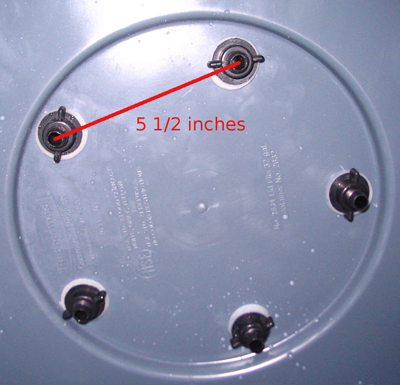 4. Take out a filter and place on washer on the stem.
4. Take out a filter and place on washer on the stem.
5. Insert the stem through the hole you just drilled through the trash can and lid.
6. Place the 2nd washer on the stem and attach the wing nut.
7. Turn the wing nut until tight. (tightening further with a pair of pliers will be necessary to make a seal for the increased water pressure, but not so much that the washer comes out from underneath the the wing nut)
8. Flip the top trash can and bottom lid upside down again.
9. Measure 5 ½ inches from the center of the stem of the filter you just installed to another point along the edge and mark it for drilling the next hole. Proceed to step 2 until all the filters have been installed. (Doing them one at a time helps make sure the holes align)
10. Put the sock filter over each filter and secure it with a rubber band around the bottom just above the plastic.
Installing the Spigots
1. Drill ¾ inch holes for each spigot a few inches above the bottom of the bottom trash can. Depending on where you set the finished filter, you may want to make one or two of the spigot holes higher to accommodate larger pots being filled.
2. Remove the spigots from the plastic packages.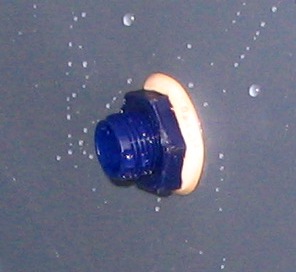
3. Place one washer on each spigot, flat side against the flange on the spigot, and insert the spigot into a hole, in the bottom trash can.
4. Place the 2nd washer onto the spigots, angled side towards the wall of the bucket, and begin to screw on the nuts.
5. You will need to use a pair of pliers or crescent wrench to get them tight enough to keep them from leaking.
6. Straighten the spigot so the handle is parallel to the bottom of the bucket.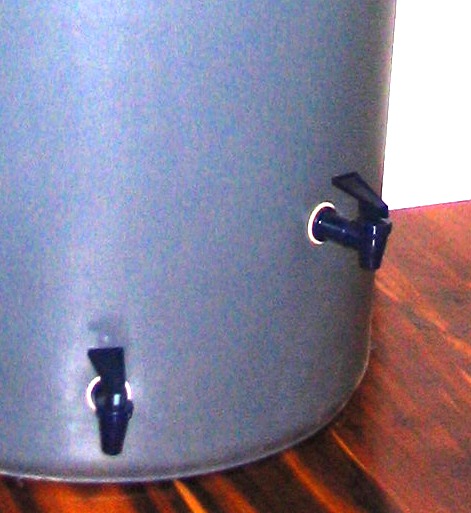
Checking for Leaks
The top trash can should be set on the bottom one with 2×4 wood blocks separating them. The top trash can should then be filled with water and the filter seals checked for leaks. If water is coming out of any place other than the center of the filter stem, it is leaking and needs to be tightened.
NOTE: It is very important that there is not a leak around the filter system. The clean water, in the bottom bucket, will be contaminated by the water from the top bucket.
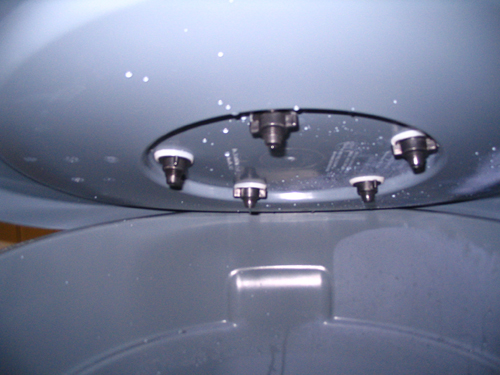 When the bottom has filled up, check each spigot and make sure there is not water leaking around it. If it is leaking, drain the trash can and tighten the nut on the inside.
When the bottom has filled up, check each spigot and make sure there is not water leaking around it. If it is leaking, drain the trash can and tighten the nut on the inside.
Filling Instructions
1. Before using the filter system it is recommended to sanitize the bottom trash can with a diluted bleach solution. 1 teaspoon of bleach mixed with 1 gallon of water will do the job.
2. Wipe down the inside of the bottom trash can and its lid with the bleach solution. Let stand for 3-5 minutes, then wipe off with a dry paper towel or cloth towel.
Cleaning Instructions
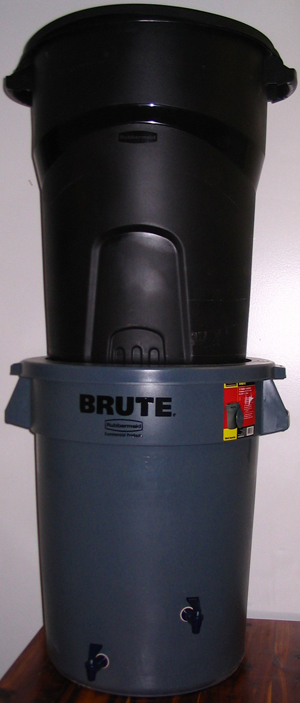
1. When the flow rate of the filter decreases, this would indicate that the sock and the filter might need to be cleaned.
2. Using rubber gloves remove the sock and rinse it in clean water.
3. As the filter is used and is in contact with dirty water, the white ceramic shell will become stained and the pores of the clay will become clogged with particulates.
4. Using a Scotch-Brite pad (green scrub pad) GENTLY rub the surface of the filter. This will remove some of the stain and the dirt.
5. Rinse with clean (filtered) water.
6. Put the sock back on and fill it with water.
NOTE: Never use any type of soap while cleaning the buckets, the socket or the filter. This will ruin the filter and will no longer function properly.
IMPORTANT: Once you start using the filter, the activated carbon is only good for about 6-8 months. The ceramic shell, which is filtering out the bacteria, will last between 1-2 years. The carbon, inside the ceramic shell, will become packed over a period of time and you will need to shake the filter, to loosen the carbon. Replacing the filter depends upon the flow rate. If the flow rate is very slow even after cleaning the filter, it should be replaced.
Click here to buy the KIS Drip Filter System.

